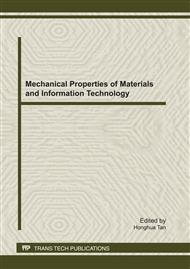[1]
A. Ngomsik, A. Bee, and M. Draye, Magnetic nano-and microparticles for metal removal and environmental applications: a review, Comptes Rendus Chimie, vol. 8, no. 6, pp.963-970, March (2005).
DOI: 10.1016/j.crci.2005.01.001
Google Scholar
[2]
N. Booker, C. Rithchie, and D. Sudarmana, Sewage clarification with magnetite particles, Water Science Technology, vol. 123, no. 32, pp.1703-1712, January1991.
DOI: 10.2166/wst.1991.0625
Google Scholar
[3]
L. Oliveira, V. Rios, and D. Fabris, clay-iron oxide magnetic composites for the adsorption of contaminants in water, Appl. Clay Sci, vol. 22, no. 4, pp.167-177, April (2003).
DOI: 10.1016/s0169-1317(02)00156-4
Google Scholar
[4]
J. Hu, G. Chen, and I. Lo, Removal of Cr(Ⅵ) by magnetite nanoparticle, Water Sci Technol, vol. 50, no. 12, pp.139-146, July2004.
Google Scholar
[5]
S. Banerjee, and D. Chen, Fast removal of copper ions by gum Arabic modified magnetic nano–adsorbent, J. Hazard. Mater, vol. 147, no. 3, pp.792-799, June (2007).
DOI: 10.1016/j.jhazmat.2007.01.079
Google Scholar
[6]
I. Safarik, M. Safarikova, and V. Buricova, Sorption of water soluble organic dyes on magnetic poly, Water Research, vol. 60, no. 22, pp.1448-1456, March (1998).
Google Scholar
[7]
S. Bailey, T. Olin, and R. Bricka, A review of potentially low cost sorbents for heavy metals, Water Research, vol. 33, no. 11, pp.2469-2479, June1999.
DOI: 10.1016/s0043-1354(98)00475-8
Google Scholar
[8]
M. Sanchez, and M. Sanchez, Factors influencing interactions of organophosphorus pesticides with montmorillonite, Geoderma, vol. 29, no. 1, pp.107-118, March (1983).
DOI: 10.1016/0016-7061(83)90035-6
Google Scholar
[9]
C. Ainsworth, M. Zachara, and R. Schimidt, Quinoline sorption on Na–montmorillonite : contribution of protonated and neutral species, Clays Clay Miner, vol. 35, no. 1, pp.121-128, Month (2001).
DOI: 10.1346/ccmn.1987.0350204
Google Scholar
[10]
M. Rodriguez, J. Lopez, and S. Bruque, Interaction of phenamiphos with montmorillonite, Clays Clay Miner, vol. 36, no. 3, pp.284-288, July (1988).
DOI: 10.1346/ccmn.1988.0360311
Google Scholar
[11]
T. Shu, D. Li, and A. Scala, Adsorption of small organic pollutant from aqueous streams by aluminosilicalite–based microporous materials, Sep . Purif. Technol , vol. 11, no. 1, pp.27-36, March (1997).
DOI: 10.1016/s1383-5866(96)01005-2
Google Scholar
[12]
A. Torrents , and S. Jayasundera, The sorption of non-ionic pesticides onto clays and influence of natural carbon, Chemosphere, vol. 35, no. 7, pp.1549-1565, July (1997).
DOI: 10.1016/s0045-6535(97)00206-3
Google Scholar
[13]
G. Danis, A. Albanis, and D. Petrakis, Removal of chlorinated phenols aqueous and mesoporous alumina aluminum phosphates, Water Research, vol. 32, no. 2, pp.295-302, April (1998).
DOI: 10.1016/s0043-1354(97)00206-6
Google Scholar
[14]
K. Konstantinou, A. Albanis, and E Petrakis, Removal of herbicides from aqueous solution by adsorption on Al-pillared lays, Water Research, vol. 34, no. 12, pp.3123-3136, July (2000).
DOI: 10.1016/s0043-1354(00)00071-3
Google Scholar


